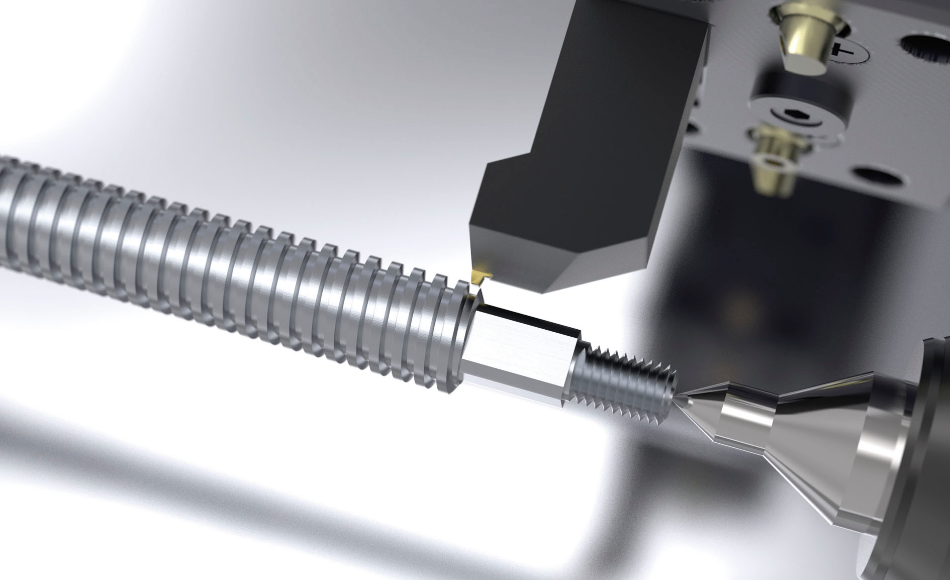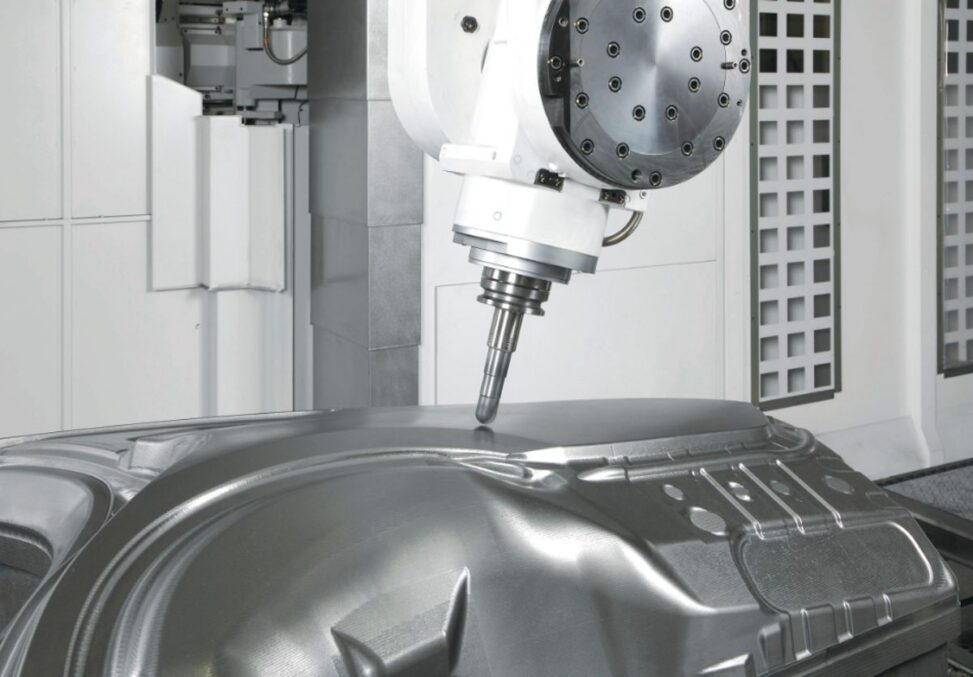Achieving supreme quality while maintaining high productivity is difficult for most manufacturers. Measures to improve the outcome often slow down machining processes. In order to combine the two partly conflicting objectives, machine tools need not only high performance hardware but also customised software to reach the machine’s full potential.
Manufacturing high-quality products when time is not important is rather easy. Likewise, mass production is no real challenge when quality remains low. Okuma, as the only single source CNC provider in the industry, combines mass production and high quality by developing software and hardware solutions that are finely tuned to each other. This allows for optimising every aspect of machining in terms of quality as well as productivity. By providing these solutions, Okuma can lower each machine’s total cost of ownership (TCO) making manufacturing processes as cost-efficient as possible for their customers.

Quality starts with the data
Okuma enables manufacturers to optimise their machining process from the earliest stage onwards. Even the best machine will not produce high-quality products if the data that is fed to it is of poor quality. Correcting such data manually is very difficult so that resulting flaws are often corrected afterwards by finishing the product by hand. To prevent these additional time-consuming steps, Okuma developed Hyper-Surface. The application corrects machining data automatically before the actual machining process by eliminating variations in command position and feed rate. This improves surface quality and helps to avoid scratches and marks eliminating the need for post-processing. This Premium Solution has been developed for double column machining centres. More machines will follow. The application helps to speed up the entire machining process and improves productivity as it includes all the features of its predecessor Super-NURBS (Non-Uniform Rational Basis Spline). Developed for manufacturing freeform objects, the application uses a mathematical method to regenerate freeform curves. During the process, machine movement commands are streamlined. By regenerating the curves, the speed of the whole machining process can be increased while the surface quality improves. The need for hand-finishing becomes obsolete.

Optimal usage of insert tools
The improvements gained from optimising data need to be maintained when it comes to the actual machining process, which includes correct tool usage. Therefore, Okuma developed a Dynamic Tool Load Control for machining centres which ensures that the inserts of a tool do not chip, allowing for high feed rates and optimised productivity. The solution measures the swing for each individual insert of a tool. The collected data is then used to optimise the feed rate relative to the tool runout, ensuring equal cutting forces for each insert. Dynamic Tool Load Control also makes the machining of demanding materials like titanium alloys more economical because it enables the use of cheaper insert tools. Without the application, manufacturers would have to purchase and use expensive solid tools.

Advanced threading
Okuma’s Variable Spindle Speed Threading is a solution that improves the cutting performance during threading operations by optimising tool use. It focuses on harmonic problems and avoids chatter during threading operations. Especially when machining long threads, vibrations may occur. The application therefore lowers the spindle speed as the cutting tool moves towards critical positions of the workpiece. While lowering the spindle’s speed, it simultaneously decreases the cutting speed to maintain an even thread. For easy threading of worm screws requiring certain pitch changes, Okuma provides Variable Lead Threading which enables manufacturers to simply enter the command per pitch. Even continuing the threading operation after processing the workpiece in another machine is made as easy as possible. While phase matching is often a problem, Okuma’s Thread Phase Matching makes this step simple by allowing for manually aligning the tool to the start position via pulse-handle. All threading solutions are available for lathes and multitasking machines equipped with a turning spindle such as the MULTUS Series.

Multitasking for higher productivity
For maximum productivity during gear manufacturing, Okuma offers Gear Machining Package for multitasking machines and 5-axis machining centres. The solution allows for machining a gear using only one machining centre within just one setup. This is a significant advantage in terms of productivity because the production of gears might require turning, milling, grinding, skiving and hobbing. Using conventional machines, the production process includes several setups on different machines, complex transportation and repeated measuring and calibration causing a slow production. Using a multitasking machining centre equipped with Okuma’s Gear Machining Package, the need for additional setups, transports and downtimes is eliminated as it provides all necessary manufacturing methods.

Next level turning
Okuma’s Premium Solution Turn-Cut revolutionises turning on machining centres and multitasking machines as it allows for an entirely new manufacturing process. Instead of rotating the workpiece during the turning process, the tool is turned around or inside the workpiece opening completely new possibilities for processing unbalanced workpieces. Also, holes of various sizes and shapes can be produced using just one tool which increases productivity tremendously as tool changes are unnecessary.

Smooth grooving
Okuma’s Flat-Tool Grooving solution for machining centres allows for an airtight machined surface and improves the surface quality of seal grooves. By using a flat tool for finishing the groove bottom it ensures high leak tightness without the need for time-consuming hand finishing as well as a successful cutting of complex seal groove curves. In order to guarantee high accuracy when grooving, the tool’s cutting edge motion is synchronised with the spindle phase.
B-axis Turning
With its Premium Solution B-axis Turning, Okuma developed a technology suited for multitasking machines that optimises turning curved surfaces. This manufacturing process usually demands a change of tool parts in order to use the best cutting tool which leads to ridges. The B-axis Turning controls the angles and therefore allows for jobs without tool changes as the tool angles are always correct. Thus, the device eliminates ridges and assures consistent high quality.

C-axis Torque Limit
To ensure an easy and automatic phase matching during the manufacturing process, Okuma provides a C-axis Torque Limit for Lathes. A stopper that contacts a keyway or notch is mounted on the turret to read the C-axis torque fluctuations and therefore allows for setting C-axis zero offsets in-machine. Phase setting without measuring devices eliminates fixture- and operator-related errors as well as expensive in-process gauging, leading to reduced costs and a faster machining process.

Measuring quality efficiently
In order to facilitate and speed up manufacturing processes, Okuma offers advanced solutions allowing for efficient measuring operations without compromising accuracy. Producing parts of excellent quality makes meticulous measuring and calibrations necessary. In terms of productivity, this poses a problem because conventional measuring methods require that machines stand still for long times. Okuma’s NC Gage measures workpieces while they are mounted on a multitasking machine. Therefore, the workpiece does not need to be moved to an additional 3D measuring device. As the gage moves while examining the machined part, the workpiece’s posture does not require changes during the measuring process.

Automated calibrations
To make calibrations of double column machining centres as fast as possible, Okuma automated this process increasing overall productivity without compromising quality. By using Okuma’s Auto Attachment Head Compensation, the time needed to adjust a new attachment head to a machine can be shortened significantly. While conventional calibration methods can take up to one whole day, the Premium Solution completes the entire process in 20 minutes. It tunes the machine to the new head by automatically measuring the head’s influence on the tool tip and then creating the compensation values. To start the process, operators simply set a datum sphere on the table and position the attachment head fitted with a touch probe directly above the sphere.
Okuma Europe GmbH is the Germany-based sales and service affiliate of Okuma Corporation, a world leader in CNC (computer numeric control) machine tools, founded in 1898 in Nagoya, Japan. The company is the industry’s only single-source provider, with the CNC machine, drive, motors, encoders, spindle and CNC control all manufactured by Okuma. Okuma’s innovative and reliable technology, paired with comprehensive, localised service protection, allows users to run continuously with confidence – maximising profitability. Along with its industry-leading distribution network, Okuma facilitates quality, productivity and efficiency, empowering the customer and enabling competitive advantage in today’s demanding manufacturing environment. For more information, visit www.okuma.eu.
- NVIDIA Announces Project GR00T - 03/21/2024
- Staying in Sync: NVIDIA Combines Digital Twins With Real-Time AI for Industrial Automation - 03/21/2024
- Radxa Rock 5A review - 03/05/2024




